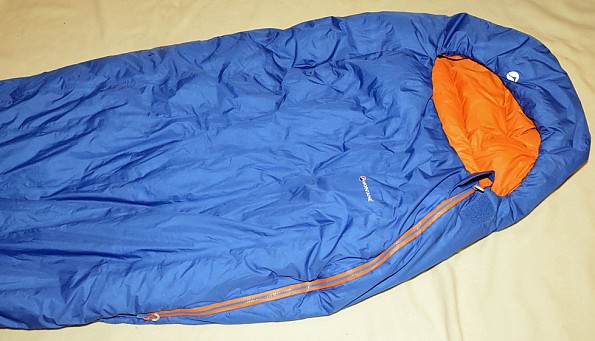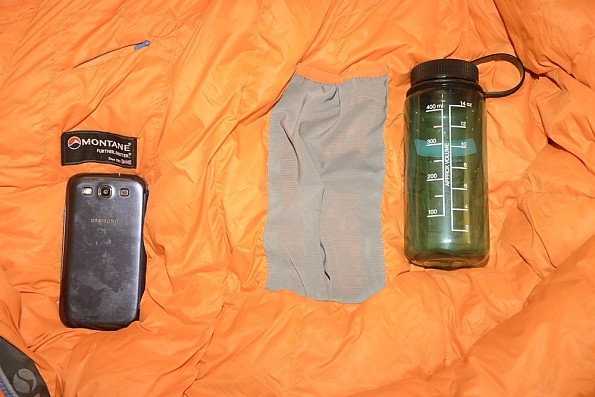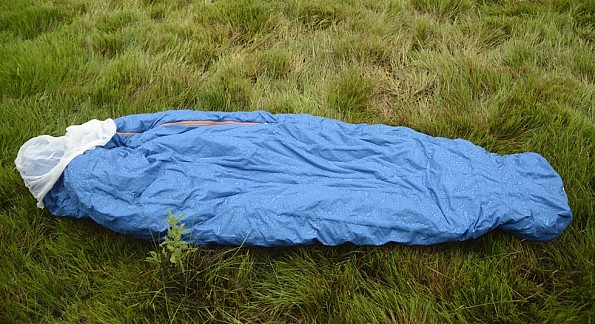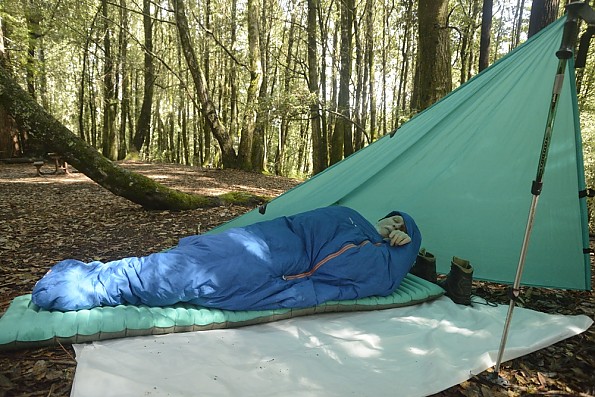Montane Minimus Sleeping Bag
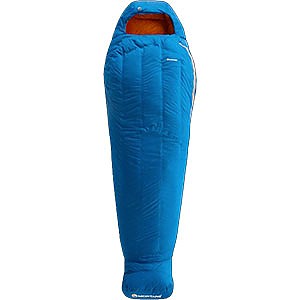
The Montane Minimus sleeping bag is very lightweight, 3-season bag, well suited for the light backpacker or climber who will be traveling in damp environments (heavy dew, occasional rainshowers) with minimal shelter, bivouacking in the open, or as an emergency backup.
Since it is quite waterproof, the Minimus can act as a combined bivy sack and sleeping bag for much less weight and is more compact. Its major flaw is that it is somewhat awkward to get into due to the zipper design.
Pros
- Waterproof shell breathes well
- Waterproof shell sheds water very well
- Lightweight
- Included drybag stuff sack has readily packable compact shape
- Stuffs small
- Zipper pulls are luminescent, easy to see in the dark
Cons
- Zipper is awkward to operate from inside the bag
- Zipper lacks pulls on inside, pulls are only on outside
- Getting in and out of bag involves a bit of thrashing around
- Getting into the waterproof bag in rain without getting water inside the bag is a bit tricky
Background:
One of the most critical items for the backpacker, climber, backcountry skier, or snowshoer is the sleeping bag. A good sleeping bag can mean the difference between a good night’s restful sleep and misery. Among the criteria are warmth to match the environment, weight of the bag in your pack, comfort to match your size, durability, and a reasonable cost for what you get.
During my life in the outdoors, I have been given, bought, slept in, and divested too many sleeping bags. I started, as most kids growing up in the middle of the Sonora Desert did, with a “bedroll”, which basically was just a wool blanket. Once I got into Scouting, I had a rectangular duck-down bag, bypassing the kapok bags that some of the other young Scouts had.
In college, having gotten involved heavily in climbing, backpacking, and winter travel in the Sierra, I scraped together enough cash to get an Eddie Bauer Karakoram bag (which I still have). I somehow learned to keep a down bag dry without any serious incidents, though we generally slept on a plastic ground cloth that we pulled over ourselves when rain or snow fell. 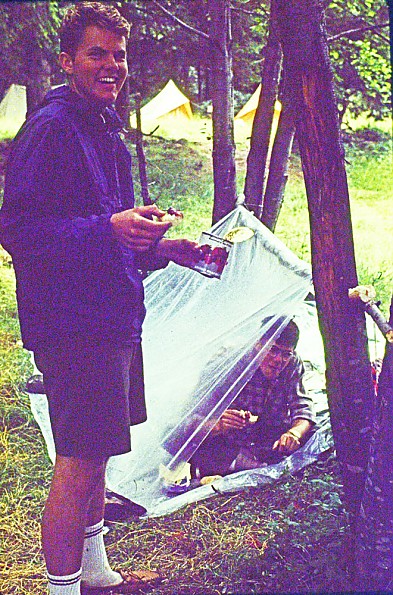
Plastic tarp setup in Biolet Campground, Chamonix, France 1964, after 3 days of constant rain
As I spent more time in inclement weather and witnessed companions who got wet, I started to use synthetic bags for summer use, because of the fact that a soaking wet synthetic bag does not hold water or lose its loft when soaking wet as does a down bag (or feathers for that matter). Many modern synthetics can be squeezed out and dried relatively easily, unlike down. However, most of my bags continued to be down, whether something little more than a thin quilt or a bag intended for -40° temperatures. Down remains the best in the warmth-to-weight ratio category, although current synthetics have come a long way.
There are some treated down products that have much reduced absorptivity and do keep most of their loft, even when wet. Make no mistake – even squeezing most of the water out of a synthetic or water-resistant down bag or garment still leaves plenty of moisture to drop your body temperature. It is not just getting water from the outside from rain, wet snow dragged into the tent, a dripping snow cave, or condensation from the tent. The human body loses 1 to 2 liters of water through perspiration (even unnoticed) and breathing. This can, and does, collect in the insulation. In winter, alpine conditions, or polar conditions, this additional water can freeze and add weight to the bag, as Will Steger’s polar expedition found when they ended up with 70 pound bags.
There have been some sleeping bags with waterproof-breathable outer shells. But these tend to feel clammy and do not breathe well. Another alternative to deal with the moisture getting into the insulation from one’s perspiration and breathing is the Vapor Barrier Liner approach. While this keeps moisture from the bag’s insulation, many people find VBLs to be very uncomfortable.
Details:
When Trailspace’s Chief of Gear Reviews, Seth, was looking for someone to test the Montane Minumus sleeping bag, I was curious to find out how this down bag (90% plumules, 10% feathers, 800+ fill) with an outer shell claimed to be very waterproof (20,000 mm hydrostatic head) and breathable (25,000 MVTR) would measure up.
The bag is one of five down bags in Montane’s line of highly technical bags that they claim “redefine performance, comfort, and use”. Two of the bags are rated to lower temperatures (“extreme conditions mountaineering” and “alpine mountaineering”) while the other two are for warmer temperatures (“fast alpine” and “super lightweight summer”). The Minimus is listed as “waterproof super light highly breathable”. The big question is “for what conditions and use is this bag intended?”
Given that Montane is a British company, one thought is that hillwalkers in the Midlands and Highlands might well find this a suitable bag, considering the often foggy conditions and drizzly rain that are found there. Snow caves are often damp and drippy, and the inside temperature of such shelters is within the specified comfort range of the bag (on the three-level EN 13537:2012 scale, “comfort” is 37°F/3°C; “comfort limit” is 28°F/-2°C; and “extreme” is 0°F/-18°C).
Comfort does depend on what clothing you wear in the bag, of course. And, yes, I know that in the Trailspace list of things, the bag is grouped with bags that are "35°F and above".
The curved zipper
When I opened the shipping box, I found the sleeping bag inside the included cotton storage sack along with a drybag stuff sack. Since the bag is filled with 800+ down, it stuffs quite small. The bag itself is an “electric blue” with a “tangerine” interior liner. The nominally half-length zipper is also electric blue” and “tangerine”.
Most bags for backpacking and expedition use these days have a full length zipper. The actual zipper measures 1/3 of the bag’s length and is a separating zipper, with pulls for both directions. However, the pulls are on the outside only – there are no pulls on the inside to ease exit and zipping up on entry. The zipper separates at the lower end, and has a “Velcro” cover at the top to prevent unintended unzipping during the night. The two zipper pulls glow in the dark, making them easy to find.
A nice touch is the two hanging loops at the foot, intended for storage and for drying the bag after washing. The curve to the zipper is intended to have the draft flap (filled with down) cover the zipper at all times to prevent cold outside air from coming into the bag (in some bags with straight zippers, the draft flap can be easily pushed out of position when the sleeper turns, and in one bag I have, the flap is attached below the zipper, where it often drops down to completely uncover the zipper).
The luminous zipper pulls (external pulls only!)
Testing details:
The first step was to weigh the bag. In its dry stuff sack, I weighed it to be 1 pound 15-3/8 ounces/890 grams. Interestingly, the catalog gives a 1005 gram stuffed weight, while the hangtag gives the same as I measured. The bottom of the bag is covered with “non-slip silicone roundels”, 0.5 in/15 mm circular “sticky” spots to reduce slippage on your sleeping pad.
Since the bag is supposed to be waterproof, I immediately headed for the shower to test this claim. I needed a shower anyway, so during the several minutes it takes to draw the hot water from the solar storage tank, I held the bag under a fairly brisk shower (keeping the face hole downstream of the shower). After taking it out of the shower, I shook the bag a couple times, which removed all but a few tiny droplets of water (I subjected the bag to several hours of natural rain later in the testing). After drying myself off, I checked the inside of the bag and found no indication of any water getting into the down.
The zippered pocket (left, above the phone) and water bottle pouch (at right, next to the 500 ml water bottle)
Inside the bag, at chest level, there is a tiny zippered compartment, intended for your MP3, smart phone, or other electronic widget, and an elasticized pocket intended for a water bottle. As can be seen in the photo, both compartments are too tiny for their intended purposes. You could put your watch in one of the pockets, which might allow the alarm to waken you in the morning.
I tried several times putting my glasses or Galaxy S3 in the elasticized pocket, only to find them dropping out and almost getting rolled on several times. Perhaps you could put one of the tiny bottled water containers in the water pocket. But the half-liter bottle in the photo definitely does not fit. My tiniest MP3 player will fit the zipper pocket, but if you turn much in your sleep, you will get the cable wrapped around your neck.
Field testing:
I took the Minimus into the field to sleep under the stars, in my Hilleberg Suolo, and in damp conditions several times, temperatures ranging from the mid 40°F range down to 25°F. I also set the bag out in the rain during a couple of the rainstorms we finally got here in the SFBay Area, after months of dry conditions well into what traditionally has been our rainy season.
Unfortunately, during the few times we did get rain in this third dry year, I did not get to spend a full night out in the rain. I did get plenty of heavy dew nights, though, with condensation on the outside of the bag (the down inside remained dry).
The Minimus in the sedge meadow, after getting rained on for 5+ hours
In the image, the bag is in a sedge meadow (with a yarrow plant in the foreground). I placed a plastic bag over the face hole to keep the rain out. I had yet to solve the problem of entering and exiting the sleeping bag when out in the rain like this without getting water inside, aside from having at least the head end under a SilTarp (which was my solution for a test).
The next image shows the foot end of the bag with water pooled on it after six hours of rain. It also shows the enlarged foot box, which is intended to provide more room for your feet, especially when lying on your back. I found that it is not as comfortable for the feet if you are a side-sleeper as I am, and that my feet tended to get a bit cool. 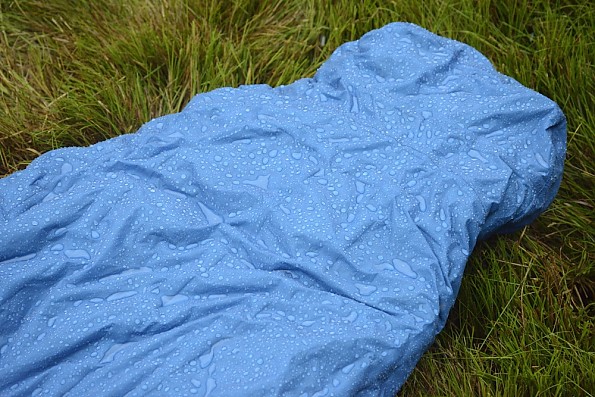
The enlarged foot box to allow feet held vertically while lying on your back
Each time I got the bag intentionally wet in the rain, I only had to shake the bag to get rid of the water. Although I was expecting to sooner or later get water into the down (except for blocking the face hole), simply shaking the bag removed all but tiny droplets of water. If you click on the picture below, then select “original”, then the magnifying glass, you may be able to see the remaining droplets. 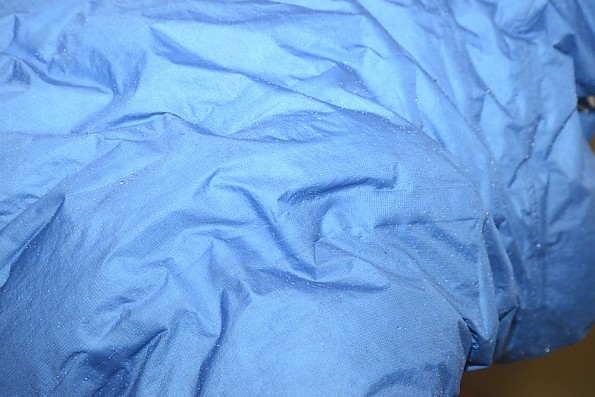
After shaking the Minimus, most of the water is gone and the bag is almost dry (no dampness inside the bag)
For the temperature limit test, I took the bag with me on my Carson Pass Epic (see my trip report). I was aware that the forecast low temperature of 25°F was below the posted “comfort limit” of 28°F/-2°C. However, I took several extra layers with me in anticipation. Sure enough, the temperature when I set up camp at Frog Lake was already in the low 30s, and was 25° inside the tent when I got up in the morning. When I first got into the bag in the tent, the temperature was still above 30°. But it dropped steadily, and I kept adding layers – a Nanopuff, a DriClime, and finally my Dolomiti jacket, having kept my Alpine Guide Pants on the whole time.
At those temperatures, I did not have to worry about getting into the bag with wet clothes on. I often tend to sleep warm, leading me to estimate that, despite the European Norm test guide, Montane may be a slight bit optimistic in their ratings. During the Carson Pass trek, I slept on Barb’s NeoAir XTherm pad, which has a rating of R-5.7, so the underside was plenty warm. As a 3-season bag, the bag is plenty warm. During my several outings, I slept comfortably at temperatures in the low 40s to upper 30s (°F).
In several of the outings, I found some condensation around the face opening on the outside of the bag from my breathing or dew from condensation. But at no time did I find any condensation or dampness inside the bag.
My solution for the entry-exit in rain was to set up my Integral Designs 5x8 SilTarp as a hood over the bag and pad, which in turn were on a plastic ground sheet, much as in the picture of my partners in the Biolet Campground in Chamonix above, leaving the foot of the bag out from under the tarp.
It was my intention to sleep out in the actual rain. My dilemma was how to get into the bag while it is raining without getting water in through the unzipped opening. I planned on using the weekend of the outdoor session of the High Adventure Training course for adult Scout leaders, which was predicted to have a fairly long period of rain. Unfortunately my duties as staff member (and insistence of my tentmate/spouse) precluded the experiment during the session itself.
The following weekend, I settled on pitching my 5x8 Integral Designs SilTarp as an ultralight shelter, using a 4-mil painter tarp for the ground cloth and an adjustable expedition pole for the support of the one corner, as seen in the photo. This has worked for me many times using a bivy sack. This time, my plan was to have the head end of the bag under shelter, along with the other gear I needed to keep dry and for doing my cooking, leaving most of the lower part of the bag out in the rain.
The tarp was set in the windward direction for the prevailing winds at the camp, though given the heavy tree stances, there would be little wind at ground level. I set up in a beautiful site in one of our Scout Councils two camps in the Santa Cruz Mountains in a redwood forest with a mixture of tan oaks and beech. The night was plenty comfortable, but the fickle weather decided that this was not the time for rain (it appears that we are back to “drought mode”, and no more “rainy season” this year – many cities around Northern California have declared mandatory 20% or more water restrictions).
However, given the shower test plus leaving the Minimus out in several 24-hour rainstorms in the back yard, I am quite confident in the waterproof outer shell, despite not actually spending a full night completely exposed in the bag to a serious downpour.
My tarp set up in anticipation of the rain that never came - we are back to drought conditions!
All this experimentation made me realize that this bag can be the solution to one of the mountaineer's problems – having a waterproof shelter with warmth during a bivouac. I have often carried a bivy sack and an “elephant’s foot” (a short sleeping bag) or used a combination of pack for a waterproof leg cover with the elephant’s foot inside, while wearing a cagoule over my parka.
With the Minimus, there is no need to carry the elephant’s foot or to empty the pack to stick your feet in it, since the Minimus is already waterproof. You will need to take off your boots (and crampons, of course), which can go in the pack in the space vacated by the Minimus. The cagoule helps solve the rain in the entry problem.
I tried this out and found that it works well, as far as getting into and out of the waterproof setup. I plan on doing an update, if I can get a rainy night during a campout in the next few months.
My biggest complaint about the bag stems from Montane’s intentional decision to have the zipper make a large curve as it comes up to the face hole. Without inner pulls on the zippers, closing the zipper is rather awkward.
A slightly lesser complaint is that the 1/3 length zipper (which they claim is ½ length) makes it awkward to get into and out of the bag in a small solo tent, like my Hilleberg Suolo. In the photo under the SilTarp, you can get some idea of how awkward it is to finish or start the zipper from the top without an inner pull (note the position of my hand as I am trying to finish pulling the zipper fully closed).
The video, which was shot indoors, demonstrates this awkwardness more clearly. I did get better with practice. I do apologize in advance for the crudeness of the video. This is my first attempt at shooting and including a video on Trailspace. My patient spouse, Barb, acted as cinematographer.
The other problem with the zipper, as can be seen in the video is that, as a two-way zipper, you do have to rejoin the two sides of the zipper. The stitching being what it is, with overlaps for rain protection, makes the joining of the zipper halves at the lower end fairly clumsy. During usage over a number of nights sleeping in the bag, the zipper did begin to work in and operate more smoothly. Using the old trick of rubbing a bit of paraffin on the zipper also helped. Even after a number of nights in the bag, I have not figured out the real benefit of the 2-way, separating zipper, with the possible exception of some extra ventilation on very warm nights. One use of separating 2-way zippers on sleeping bags is joining 2 bags. But this applies to full-length zippers, not a nominally half-length which is actually a 1/3 length.
Conclusions:
So what is the actual benefit of a waterproof bag, if you are dragging the rain in with you when you get in the bag, plus you have the face open to the rain? Under most circumstances, you have to have a tent or at least a tarp. If you are already in the bag when the rain starts, sleeping in the open as we often do in the Sierra and Rockies, it would at least keep you dry through the night.
The Minimus is light enough to carry as an emergency bag when you might have precipitation, such as a summer climb or hike in the Cascades or New Hampshire’s White Mountains. The biggest problem is getting into or out of the bag without getting significant moisture in with you.
One friend suggested that wearing a cagoule to pull the bag up around you or an umbrella or tarp for shelter as you get in would work. Certainly, in my tarp camping days, we kept a whole bag without a waterproof shell dry enough under the tarp or in a tube tent.
Overall, the Montane Minimus seems very good as a lightweight 3-season bag. The major benefits would be in areas where condensation, fog, or drizzle is a problem. One situation would be keeping condensation off of the bag inside the tent (and probably reducing the amount of condensation gathering on the tent walls in the first place).
Another situation would be when traveling very light, for instance on a through-hike on trails like the John Muir, Pacific Crest, or Appalachian Trails. In those cases, the lightness of the bag (under 2 pounds in its stuff sack), combined with the reduced worry of getting the down wet under a tarp shelter, seems an ideal situation. Blowing rain is not going to be a problem.
As noted, the bag does appear to breathe well during the nights I have slept in it (no condensation on the inside of the shell in the down). As a 2 pound bag, it isn't a winter bag, as I proved thoroughly during the weekend at Carson Pass (I had put on all my insulating layers, including my Dolomiti jacket by the time the measured temperature got down to 25°F.)
Based on my experience with the bag, it would be well suited for someone traveling minimally, sleeping in the open, possibly in a foggy area (since the bag is Brit manufacture, I think of the Scottish Highlands); with a tarp where it might rain or have rain blowing in under the tarp (a minimalist or Ultralight enthusiast); someone with a single-wall tent that tends to condense a lot; or for someone sleeping in snow shelters (snow cave or igloo, in which the temperatures generally remain in the 25-35°F range).
It would also work well where there is heavy dew, such as areas of the US with high humidity; along river runs; or in my area of Northern California, among the coastal redwoods, which collect water from the fog during the night, creating mini-rainstorms.
Source: received for testing via the Trailspace Review Corps
(Sample provided by Montane for testing and review)


